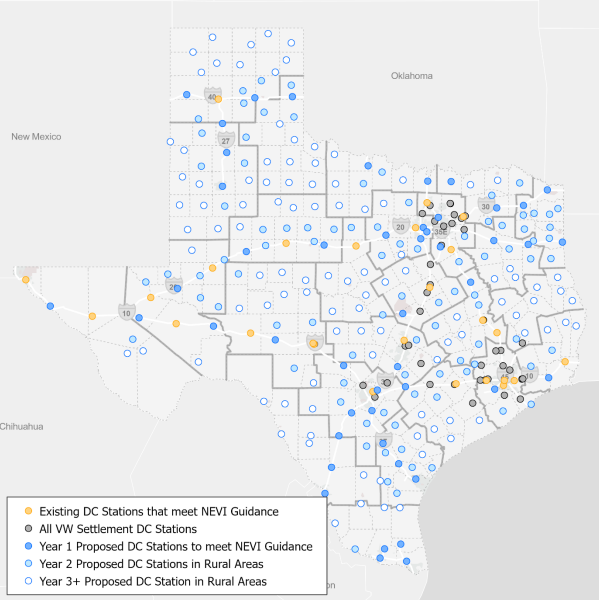TxDOT releases draft EV charging plan
The Texas Department of Transportation (TxDOT) unveiled a draft Texas Electric Vehicle Infrastructure Plan on June 7 that aims to develop a charging network capable of serving millions of electric vehicles (EVs) in the coming years.
Electric Reliability Council of Texas (ERCOT) estimates there will be 1 million electric vehicles on the road in Texas by 2028. Using current growth trends for EVs, the Texas Department of Motor Vehicles estimates Texas will reach 1 million EVs by 2031.
The plan also intends to comply with federal guidelines, take public feedback into account, and respond to Gov. Greg Abbott’s direction.
 In a March letter, Abbott instructed TxDOT and stakeholders to include in the plan a way for Texans to easily get from Beaumont to El Paso and Texline to Brownsville in an electric vehicle (EV) – with a focus on rural placement and connectivity.
In a March letter, Abbott instructed TxDOT and stakeholders to include in the plan a way for Texans to easily get from Beaumont to El Paso and Texline to Brownsville in an electric vehicle (EV) – with a focus on rural placement and connectivity.For fiscal years 2022-2026, Texas will receive $407.8 million, with the Federal Highway Administration (FHWA) apportioning $60.4 million of that already for FY 2022. The funds will be split 80 percent federal, 20 percent state, with third parties funding the state’s share. No state funds will be used.
To receive the funds, TxDOT must submit an EV Infrastructure Deployment Plan by August 1 to FHWA describing how it intends to use its National Electric Vehicle Infrastructure (NEVI) funds.
The density, distribution, and power of the EV network outlined in this multi-year plan is targeted to support 1 million electric vehicles when built out.
DC fast charging stations will be 50 miles apart on the Electric Alternative Fuel Corridors and usually 70 miles apart anywhere else in the state. Drivers will have multiple options for EV charging along their intended travel route.
Every corridor charging location will have at least four units each rated to deliver 150 kilowatts of power. The stations will have room for pull through spaces for passenger vehicles pulling trailers or recreational vehicles. Locations will be discoverable online at the U.S. Department of Energy Alternative Fuel Data Center and various third-party applications.
To meet FHWA requirements, the chargers – which also must be available at or near every county seat – will be within 1 mile of interstate exits. TxDOT estimates 48 new locations will be needed to satisfy the 50-mile maximum spacing requirements from FHWA. The 48 new locations will complement 27 existing locations installed by the private sector and 26 planned locations resulting from Volkswagen settlement grants that meet FHWA requirements.
Spacing off the corridors could be slightly greater (70 miles) in rural counties due to distances between population centers and electrical supply lines in west Texas. Large urban areas will utilize a combination of DC and Level II charging across their respective areas. The mix and location of chargers will be determined based on equipment cost, access to power, community identified needs, and how long a vehicle is parked.
After concluding a public comment period on June 22, TxDOT plans to submit its EV plan to the FHWA by August 1 and publish solicitations on October 1. It is targeting January 2023 to award contracts for stations on Electric Alternative Fuel Corridors.

 512-531-3900
512-531-3900 Request More Info
Request More Info